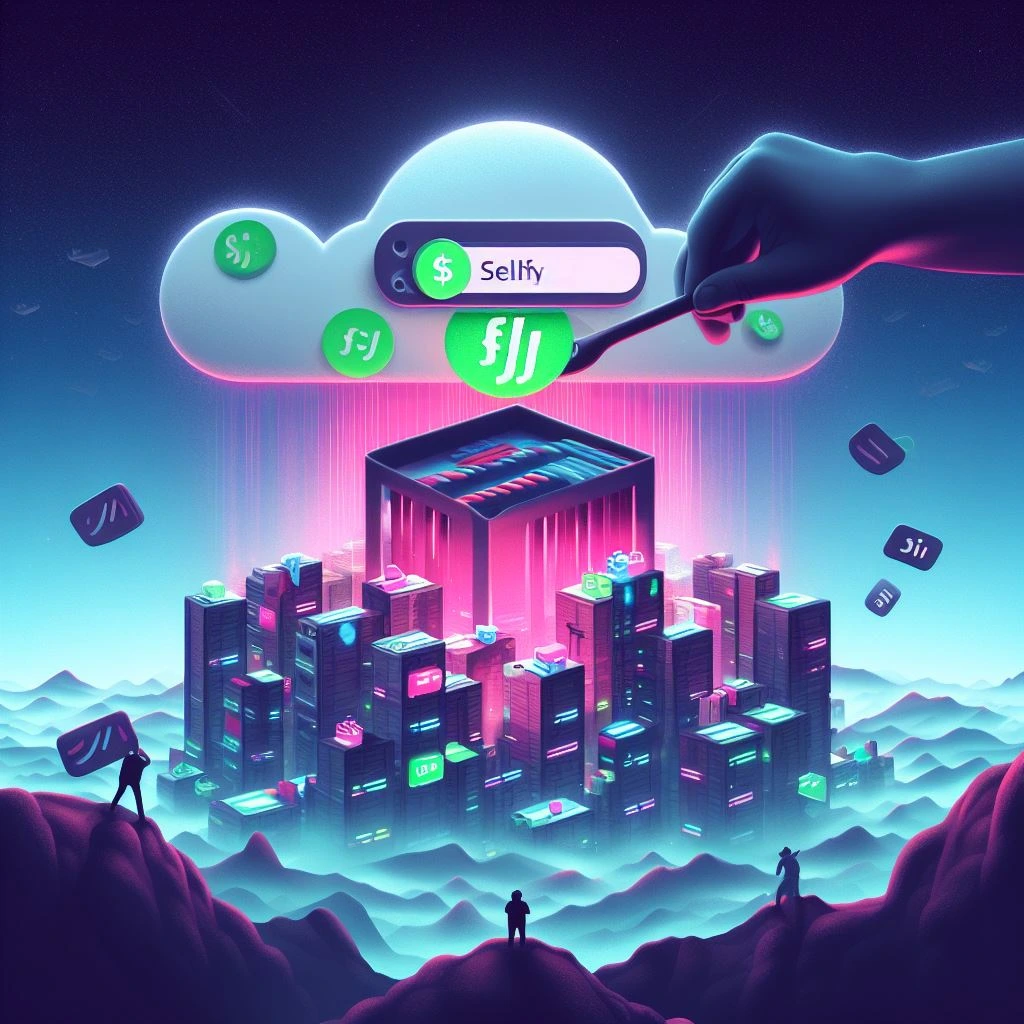In order to decide which ecommerce platform to use, Sellfy vs Optimizely. A detailed comparison between features must be thoroughly done. If you want to decide which eCommerce platform to choose, there are many things to consider.
These are some examples of these factors:
- Cost.
- SEO friendliness.
- Page load speed.
- Canonical website URL.
- Indexing Control.
- Customizable HTML capabilities.
- Sitemap Generator.
- Integration with Google Analytics.
- Product Tagging and Categorization.
- Batch Uploading.
- Mobile Optimization.
- Built-in Blogging and Marketing Features.
- Social Sharing Buttons.
- Content Management Capabilities.
- Discount and promotion code tools.
- Easy to use Checkout.
- Reporting tools and custom reports.
- Integration of email marketing tools.
- Multiple payment options.
- Flexibility to add new eCommerce features.
- Exclusive features.
- Cons and pros.
Here we’ll discuss these factors to help you decide which platform is better for you, Optimizely or Sellfy. And at the end of the discussion, we’ll recap and make a comparison for the scores of all these points to find out which eCommerce platform has the higher score, so that you’ll have a good view about both of them.
Read Further: Top 6 Sellfy Reviews
Pricing (Sellfy vs Optimizely):

While comparing Sellfy and Optimizely, it’s important to note that they cater to different segments:
Sellfy:
- Focuses on eCommerce, enabling you to sell digital and physical products, subscriptions, and memberships.
- Offers 3 paid plans: Grow, Pro, and Business, ranging from $19 to $99 per month.
- Free plan available with limited features and revenue cap.
Optimizely:
- Focuses on website experimentation and A/B testing to optimize user experience and drive conversions.
- Offers 6 tiers: Starter, Essential, Business, Enterprise, Custom, and Consulting, with prices starting at $79 per month.
- No free plan available.
Therefore, a direct comparison of pricing wouldn’t be entirely accurate. However, to help you understand their cost structures:
Considerations for Sellfy:
- Choose a plan based on your expected sales volume and desired features.
- The free plan might be suitable for testing the platform, but limited functionalities and revenue cap restrict growth.
- Paid plans offer advanced features like abandoned cart recovery, custom domains, and analytics.
Considerations for Optimizely:
- Pricing depends heavily on the number of visitors you have and the number of experiments you want to run.
- Higher tiers offer advanced features like personalization, multivariate testing, and user insights.
- Consider consulting their sales team for custom quotes if you have complex needs.
Additionally:
- Transaction fees: Sellfy applies transaction fees on lower-tier plans, while Optimizely doesn’t have direct transaction fees.
- Payment gateways: Both platforms integrate with various payment gateways, which might have their own fees.
- Integrations: Some integrations with third-party tools might involve additional costs on either platform.
Recommendations:
- Clearly define your needs and priorities: Are you primarily focused on eCommerce or website optimization?
- Evaluate your budget: Which platform and pricing tier aligns with your financial resources?
- Consider potential hidden fees: Analyze transaction fees, payment gateway charges, and integration costs.
- Seek advice from experts: Consult with website developers or marketing professionals for guidance on the most suitable platform for your specific needs.
SEO Capabilities (Sellfy vs Optimizely):

While both Sellfy and Optimizely have features related to search engine optimization (SEO), their focus and capabilities differ significantly:
Sellfy:
- Offers basic SEO tools like:
- Page title and meta description optimization
- Image alt text editing
- Mobile-friendly design
- Basic sitemap generation
- Limited control over technical SEO aspects like:
- URL structure customization
- Robots.txt management
- Canonicalization
- Page loading speed optimization
- Relies primarily on content quality and product descriptions for organic traffic generation.
Optimizely:
- Doesn’t directly offer built-in SEO tools
- Focuses on A/B testing and website experimentation to optimize content and landing pages for better search engine rankings.
- Allows testing of various SEO elements like:
- Headlines and meta descriptions
- Call to action buttons
- Content placement and formats
- Internal linking structures
- Provides data and insights to identify what resonates best with users and search engines.
Considerations:
- If your primary goal is technical SEO optimization, Sellfy’s limited tools might not be sufficient.
- Optimizely offers indirect SEO benefits through A/B testing and data-driven optimization of elements that search engines consider.
- You might need to use additional SEO plugins or tools with Sellfy for comprehensive optimization.
- Optimizely requires an understanding of SEO principles and testing methodologies to leverage its capabilities effectively.
Recommendations:
- For basic SEO and focusing on product content, Sellfy’s tools might be adequate.
- For advanced SEO optimization and data-driven testing to improve search rankings, Optimizely offers valuable insights and experimentation capabilities.
- Consider combining Sellfy with dedicated SEO plugins for a more comprehensive approach.
- If you lack SEO expertise, consider consulting with SEO professionals or utilizing Optimizely’s support resources to maximize its SEO benefits.
PageLoad Speed (Sellfy vs Optimizely):

Here’s a comparison of Sellfy and Optimizely regarding Page Load Speed, considering their distinct natures:
Sellfy:
- Complete eCommerce platform: Handles entire website and store infrastructure, directly impacting overall page load speed.
- Generally boasts fast loading times: Optimized for product pages and checkout processes, crucial for eCommerce conversions.
- Key factors affecting speed:
- Theme choice (some themes might be heavier than others)
- Number of products and images
- External apps or integrations
- Hosting plan (shared or dedicated)
Optimizely:
- Experimentation platform: Overlays on existing websites, adding JavaScript code for testing and personalization.
- Potentially impacts page load speed if not implemented carefully:
- Minimizes speed impact through efficient code and selective loading of experiments.
- Offers tools to monitor and address speed issues related to experiments.
Canonical Website URL (Sellfy vs Optimizely):

Here’s a comparison of how Sellfy and Optimizely handle canonical URLs, considering their distinct purposes:
Sellfy:
- Complete eCommerce platform: Controls entire website structure and URL management.
- Built-in canonical URL settings:
- Accessible within product page settings.
- Specify the preferred URL version to avoid duplicate content issues.
- Automatic canonical tags:
- Generally adds canonical tags to product pages and other key pages automatically.
Optimizely:
- Experimentation platform: Overlays existing websites, often without direct control over canonical tags.
- Recommendations for canonicalization:
- Use URL targeting for experiments to ensure consistency and avoid duplication.
- Work with developers to add canonical tags manually if necessary.
Indexing Control (Sellfy vs Optimizely):

Here’s a comparison of Sellfy and Optimizely regarding indexing control, acknowledging their different approaches:
Sellfy:
- Complete eCommerce platform: Offers built-in tools for basic indexing control, but options are limited.
- Available features:
- Robots.txt file editing: Control which pages search engines can crawl and index.
- Meta robots tags: Set individual pages to “noindex” or “nofollow” as needed.
- Password protection: Prevent indexing of specific pages or content.
- No advanced indexing control: Lacks features like sitemap generation or granular control over indexing behavior.
Optimizely:
- Experimentation platform: Focuses on testing and personalization, with minimal direct indexing control.
- Recommendations for indexing:
- Use URL targeting to ensure experiments don’t affect indexed content.
- Work with developers to implement JavaScript-based indexing control for complex scenarios.
Key Considerations:
- Platform integration: If using Optimizely on a Sellfy store, carefully coordinate indexing strategies to avoid conflicts.
- Technical expertise: Advanced indexing control on either platform might require developer assistance.
- External tools: Consider using third-party SEO plugins or apps to extend indexing control capabilities for Sellfy stores.
Customizable HTML Capabilities (Sellfy vs Optimizely):

Here’s a comparison of Sellfy and Optimizely regarding customizable HTML capabilities:
Sellfy:
- Limited HTML customization:
- Primary focus on user-friendly visual editing and pre-built themes.
- Offers some HTML editing options within product descriptions and certain page sections.
- No direct access to core theme files for extensive customization.
Optimizely:
- Extensive HTML customization:
- Designed for experimentation and personalization, allowing direct HTML code editing.
- Target specific elements for modification using their visual editor or code editor.
- Create entirely new page layouts or elements without relying on themes or templates.
Key Considerations:
- Technical expertise: Optimizely’s flexibility requires a greater understanding of HTML, CSS, and JavaScript.
- Potential for errors: Incorrect code modifications in either platform can lead to website errors or display issues.
- Integration with other tools: Sellfy might integrate with third-party tools for extended customization options, but this can add complexity and costs.
Sitemap Generators (Sellfy vs Optimizely):

Sellfy:
- Built-in basic sitemap generator:
- Automatically creates a simple sitemap containing primary pages and product listings.
- Offers limited customization options for filtering or excluding specific URLs.
- No advanced sitemap features:
- Lacks capabilities for custom sitemap generation or submission to search engines.
Optimizely:
- No direct sitemap generator:
- Primarily focuses on experimentation and personalization, not website infrastructure.
- Recommendations for sitemaps:
- Use the sitemap generated by your underlying website platform or CMS.
- Integrate with third-party sitemap generation tools if extensive customization is required.
Key Considerations:
- Platform integration: If using Optimizely on a Sellfy store, ensure the generated sitemap includes both core pages and experiment variations.
- External tools: Consider using third-party sitemap generators for Sellfy stores to extend control and customization.
- Technical expertise: Advanced sitemap generation might require developer assistance on either platform.
Best Practices:
- Start with Sellfy’s built-in sitemap: It provides a basic foundation for search engines to discover your content.
- Work with developers or SEO experts to enhance the sitemap: If necessary, add custom URLs, filters, and submit it to search engines.
- Coordinate with Optimizely experiments: Ensure experiment variations are included in the sitemap to avoid indexing issues.
- Regularly monitor sitemap health: Use SEO tools to check for errors or outdated content.
Integration With Google Analytics (Sellfy vs Optimizely):

Sellfy:
- Direct integration:
- Built-in feature to connect your Sellfy store with Google Analytics.
- Automatically tracks key eCommerce metrics like sales, conversions, and product performance.
- Offers basic customization for tracking events or goals.
Optimizely:
- Two-way integration:
- Connects with Google Analytics for both data sharing and experiment optimization.
- Sends experiment data to Google Analytics for in-depth analysis and reporting.
- Uses Google Analytics data to segment audiences and personalize experiments.
Key Considerations:
- Ease of setup: Sellfy’s direct integration is often simpler to establish.
- Data depth: Optimizely provides a richer integration, enabling more comprehensive analysis and personalization.
- Technical expertise: Optimizely’s two-way integration might require greater technical knowledge to set up and utilize fully.
Product Tagging and Categorization (Sellfy vs Optimizely):

Sellfy:
- Built-in product organization features:
- Assign products to multiple categories and subcategories for structured browsing.
- Add tags for descriptive keywords or attributes to enhance search and filtering.
- Customizable product filters:
- Enable customers to refine product listings based on tags and categories.
- Direct impact on store navigation and search:
- Affects how customers discover and access products.
Optimizely:
- No direct product tagging or categorization:
- Focuses on website experimentation and personalization, not product management.
- Indirect targeting using existing product data:
- Leverages existing product categories, tags, or other attributes for experiment targeting.
- Collaboration with eCommerce platforms:
- Integrates with eCommerce platforms to access and utilize product data for personalization.
Key Considerations:
- Platform integration: If using Optimizely on a Sellfy store, it can access and experiment with Sellfy’s product categories and tags.
- External tools: Consider using third-party tools for advanced product tagging and categorization on Sellfy if needed.
- Technical expertise: Optimizely’s integration with eCommerce platforms might require developer assistance.
Batch Uploading (Sellfy vs Optimizely):

Sellfy:
- Built-in bulk product upload feature:
- Dedicated tool for efficiently adding multiple products simultaneously.
- Supports various file formats for product information (CSV, XLSX, etc.).
- Saves time and effort for large product catalog management.
Optimizely:
- No batch uploading for experiments:
- Focuses on creating and managing individual experiments or variations.
- Potential workarounds for large-scale changes:
- API access for programmatic experiment creation (requires technical expertise).
- Integration with third-party tools for experiment management at scale.
Key Considerations:
- Purpose of batching: Sellfy’s feature is designed for initial product setup or ongoing catalog updates.
- Experiment scale: Optimizely’s lack of batching might be less efficient for managing numerous experiments or variations.
- Technical expertise: Workarounds for Optimizely might require developer assistance or third-party integrations.
Mobile Optimization (Sellfy vs Optimizely):

Both Sellfy and Optimizely have features related to mobile optimization, but cater to different purposes. Here’s a breakdown:
Sellfy:
- Mobile-first design: Focuses on responsive themes and layouts that adapt seamlessly to different screen sizes and devices.
- Mobile preview: Allows testing and adjusting your store’s appearance on various mobile devices.
- Mobile checkout: Ensures a smooth and optimized checkout experience for mobile users.
- Limited control over mobile-specific elements: Less customization options compared to Optimizely.
Optimizely:
- No direct mobile optimization features: Doesn’t specifically handle mobile website design or layout.
- A/B testing capabilities: Can be used to experiment with different versions of your mobile website or checkout process for improvement.
- Targeting options: Allows targeting experiments to specific mobile devices or operating systems.
- Requires technical expertise: Setting up and interpreting A/B tests for mobile optimization might require developers’ assistance.
Key Considerations:
- Prioritize mobile-friendliness: Mobile traffic is crucial, so ensure your chosen platform offers a good mobile experience.
- Sellfy’s built-in features might be sufficient for basic mobile optimization: If you’re happy with the theme and checkout experience, there’s no need for A/B testing.
- Optimizely can help fine-tune and optimize your mobile experience: If you want to test different layouts, call to actions, or features on mobile devices, it’s a valuable tool.
- Technical knowledge required for Optimizely: Consider your team’s expertise before choosing this approach.
Built-in Blogging & Marketing Features (Sellfy vs Optimizely):

When it comes to built-in blogging and marketing features, Sellfy and Optimizely take different approaches:
Sellfy:
- Offers a built-in blog platform: Allows creating and publishing blog posts directly within your store.
- Basic blog features: Editing tools, scheduling, comments, and image embedding.
- Marketing automation tools: Email marketing campaigns, coupons, abandoned cart recovery, and analytics.
- Limited social media integration: Share blog posts and products on various platforms.
Optimizely:
- No built-in blogging platform: Focuses on website experimentation and personalization, not content creation.
- Indirect marketing impact: A/B testing can optimize landing pages, calls to action, and other marketing elements.
- Requires integration with external tools: Use dedicated blogging platforms and marketing automation tools.
- No social media integration: Relies on your website’s existing social media sharing plugins.
Key Considerations:
- Purpose of blogging: Sellfy’s platform is suitable for basic content marketing within your store. Optimizely focuses on optimizing existing content and campaigns.
- Technical expertise: Optimizely requires setting up and managing integrations with external tools.
- Budget: You might need to subscribe to additional tools for comprehensive blogging and marketing with Optimizely.
Remember: Consider your content marketing goals and technical capabilities when choosing a platform. Sellfy offers a convenient built-in blogging solution, while Optimizely focuses on optimizing existing content through A/B testing and requiring external tools for robust blogging and marketing features.
Social Sharing Buttons Availability (Sellfy vs Optimizely):

Sellfy:
- Built-in social sharing buttons:
- Automatically adds sharing buttons for major social media platforms (Facebook, Twitter, Pinterest, etc.) to product pages and blog posts.
- Limited customization options: Control over button placement and appearance might be restricted.
Optimizely:
- No direct social sharing features:
- Focuses on website experimentation and personalization, not social media integration.
- Relies on existing website integrations:
- Depends on the social sharing plugins or tools already implemented on your website.
- Can be used to A/B test the placement or design of social sharing buttons for optimization.
Key Considerations:
- Ease of setup: Sellfy’s built-in buttons are simpler to implement.
- Customization needs: Optimizely offers greater flexibility for experimenting with button placement and design, but requires more technical setup.
- Existing social media tools: If you already have preferred social sharing plugins, Optimizely can work with them.
Content Management Capabilities (Sellfy vs Optimizely):

When it comes to content management, Sellfy and Optimizely cater to different needs and audiences:
Sellfy:
- Focus on eCommerce content: Designed for managing product descriptions, blog posts, and other content directly related to your online store.
- Built-in editor: Provides a user-friendly interface for crafting and formatting content without complex coding.
- Limited content types: Primarily supports text, images, and basic embeds.
- Basic SEO tools: Offers meta descriptions, alt tags, and sitemap generation for search engine optimization.
Optimizely:
- Focus on website experimentation: Not a dedicated content management system, but allows A/B testing and personalization of existing content.
- No built-in editor: Requires integration with website platforms like WordPress or Drupal for content creation.
- Broader content support: Can handle various content types including text, images, videos, forms, and widgets.
- Advanced analytics and data insights: Provides in-depth data on user behavior and content performance for optimization.
Key Considerations:
- Content needs: Sellfy is suitable for managing basic eCommerce content, while Optimizely caters to more diverse content types and experimentation.
- Technical expertise: Optimizely requires technical knowledge for content creation and integration with other platforms.
- Flexibility and control: Optimizely offers greater flexibility in content types and personalization, but Sellfy might be easier for basic content management.
Discounts & Promotion Codes (Sellfy vs Optimizely):

Sellfy:
- Built-in discount and coupon features:
- Offers tools to create discounts, coupons, and promotional codes within your store.
- Customize discounts based on percentage, fixed amount, or free shipping.
- Set expiration dates and usage limits for codes.
- Track redemption rates and campaign performance.
Optimizely:
- No direct discount features:
- Focuses on website experimentation and personalization, not eCommerce-specific features.
- Experimental approach:
- Can be used to A/B test different discount strategies, promotional messages, or code placements to determine their effectiveness.
- Integrates with eCommerce platforms:
- Works with platforms like Shopify and Magento, which have their own discount and coupon capabilities.
Key Considerations:
- Ease of use: Sellfy’s built-in features are simpler to implement and manage.
- Experimentation and personalization: Optimizely offers greater flexibility for testing different discount approaches and targeting specific audiences, but requires more technical setup and integration.
- Existing eCommerce platform: If you already have an eCommerce platform with discount features, Optimizely can complement those capabilities.
Remember: Discounts and promotions can be powerful tools for driving sales and engagement. Choose the platform that aligns with your technical capabilities and experimentation goals, and prioritize strategies that resonate with your target audience and drive conversions.
Easy to Use Checkout (Sellfy vs Optimizely):

Sellfy:
- Designed with simplicity in mind:
- Strives for a streamlined checkout process with minimal steps and distractions.
- Offers guest checkout options for quick purchases without account creation.
- Supports multiple payment gateways for customer convenience.
Optimizely:
- Not a standalone eCommerce platform:
- Doesn’t have a built-in checkout process.
- Overlays on existing websites, relying on the underlying platform’s checkout functionality.
- Can be used to A/B test different checkout experiences, forms, and messaging for optimization.
Key Considerations:
- Direct influence: Sellfy has direct control over checkout design and experience, while Optimizely’s impact depends on the underlying platform.
- Ease of use: Sellfy’s checkout is generally known for its simplicity and user-friendliness.
- Experimentation: Optimizely offers the flexibility to test different approaches, but requires technical expertise and integration.
Best Practices:
- Leverage Sellfy’s built-in checkout for a user-friendly experience.
- Utilize Optimizely to A/B test different checkout variations, such as:
- Form layouts
- Payment options
- Calls to action
- Messaging
- Integrate Optimizely with eCommerce platforms that offer strong checkout experiences.
- Continuously monitor checkout performance and make adjustments based on data and insights.
Remember: A smooth and intuitive checkout process is crucial for maximizing conversions and reducing cart abandonment. Choose the platform or combination that aligns with your technical capabilities and experimentation goals, and prioritize a checkout experience that minimizes friction and encourages purchase completion.
Reporting Tools and Custom Reports (Sellfy vs Optimizely):

Sellfy:
- Built-in reporting dashboard:
- Offers essential eCommerce metrics like sales, revenue, traffic sources, product performance, and customer behavior.
- Limited customization options for reports.
- Data export available in CSV format for further analysis.
Optimizely:
- Advanced reporting and analytics:
- Focuses on experiment performance, user behavior, and data insights.
- Visualizes results through various charts and graphs.
- Custom report creation: Build personalized reports with specific metrics and dimensions.
- Data export to CSV and integration with third-party analytics tools like Google Analytics.
Key Considerations:
- Ease of use: Sellfy’s reporting is simpler for basic eCommerce insights.
- Depth and customization: Optimizely provides more comprehensive reporting, customization, and data analysis capabilities.
- Integration requirements: Optimizely might require developer assistance for integration with other analytics tools.
Remember: Data-driven decision-making is crucial for both eCommerce and website optimization. Choose the platform that offers the level of reporting detail and customization you need to track progress, assess performance, and make informed decisions.
Integration of Email Marketing Tools (Sellfy vs Optimizely):

Both Sellfy and Optimizely offer options for integrating with email marketing tools, but their approaches differ:
Sellfy:
- Built-in email marketing features: Provides basic tools for email campaigns, including signup forms, autoresponders, and abandoned cart recovery emails.
- Direct integrations: Integrates with popular email marketing services like Mailchimp, ActiveCampaign, and ConvertKit.
- Limited scope: Focuses on eCommerce-specific emails like order confirmations, product recommendations, and abandoned cart recovery.
- Ease of use: Simple setup and management for basic email campaigns.
Optimizely:
- No built-in email marketing: Does not have its own email sending capabilities.
- Focus on A/B testing: Can be used to A/B test different aspects of email campaigns, such as subject lines, content, and calls to action.
- Integrations with tools: Requires integration with external email marketing services for sending and automation.
- Technical setup: Requires developer knowledge for advanced integrations and A/B testing of email campaigns.
- Flexibility: Offers greater customization and experimentation possibilities for email marketing optimization.
Key Considerations:
- Email marketing needs: Sellfy’s built-in features are suitable for basic eCommerce campaigns, while Optimizely caters to advanced testing and personalization.
- Technical expertise: Optimizely requires more technical knowledge for setup and integrations.
- Existing email marketing tools: If you already use a preferred service, ensure compatibility with either platform.
Remember: Choosing the right platform depends on your email marketing goals and technical capabilities. Sellfy offers a convenient built-in solution for basic eCommerce emails, while Optimizely allows for advanced testing and personalization but requires more technical expertise and integration with external tools.
Multiple Payment Options (Sellfy vs Optimizely):

Sellfy:
- Built-in payment gateway integrations:
- Offers direct connections with popular payment gateways like Stripe, PayPal, Apple Pay, and Google Pay.
- Customers can choose their preferred payment method during checkout.
Optimizely:
- Depends on underlying platform:
- Doesn’t have its own payment processing capabilities.
- Relies on the payment gateways supported by the eCommerce platform it’s integrated with.
- If used with a platform like Shopify or Magento, it will offer the payment options available on those platforms.
Key Considerations:
- Direct control: Sellfy has direct control over payment options within its platform.
- Flexibility: Optimizely’s payment options depend on the underlying platform, potentially offering a wider range or more specialized gateways.
- Technical integration: In some cases, Optimizely might require additional setup for payment gateway integrations within the underlying platform.
Remember: Offering multiple payment options is crucial for maximizing conversions and catering to diverse customer preferences. Choose the platform or combination that aligns with your desired payment gateways, technical capabilities, and the underlying eCommerce platform’s payment options.
Flexibility to Add New eCommerce Features (Sellfy vs Optimizely):

Here’s a comparison of Sellfy and Optimizely regarding the flexibility to add new eCommerce features:
Sellfy:
- Limited built-in features:
- Offers a core set of eCommerce features, designed for simplicity and ease of use.
- Extendable through third-party app integrations, but the selection is somewhat limited compared to larger platforms.
- May not be ideal for complex or highly customized eCommerce experiences.
Optimizely:
- Relies on underlying platform:
- Doesn’t offer eCommerce features itself.
- Depends on the features available on the eCommerce platform it’s integrated with.
- Flexibility is limited by the capabilities of the underlying platform.
- Not directly customizable for eCommerce features.
Remember: Flexibility is crucial for adapting to evolving eCommerce trends and customer expectations. Choose the platform that best suits your current needs, technical capabilities, and potential for future growth and customization.
Exclusive Features (Sellfy vs Optimizely):

Both Sellfy and Optimizely have unique features that give them distinct advantages, so the “best” platform depends on your specific needs and goals. Here’s a breakdown of their exclusive features:
Sellfy:
- Built-in membership platform: Create and manage subscription-based products with recurring billing and exclusive content.
- Digital downloads: Sell ebooks, music, software, and other digital products seamlessly.
- Print-on-demand products: Offer physical merchandise like t-shirts, mugs, and phone cases without managing inventory.
- Affiliate marketing: Recruit affiliates to promote your products and earn commissions on their sales.
- Embeddable buy buttons: Add “Buy Now” buttons to any website or blog to sell directly.
Optimizely:
- A/B testing and personalization: Experiment with different website elements, layouts, and messaging to optimize conversions and engagement.
- Behavioral targeting: Personalize the website experience based on user behavior and characteristics.
- Funnel analysis: Track user journeys through your website and identify conversion bottlenecks.
- Integrations with various tools: Connect Optimizely with CRM, analytics, and marketing automation platforms for a unified workflow.
- Advanced reporting and analytics: Gain in-depth insights into user behavior, campaign performance, and website optimization opportunities.
Remember: Choosing the right platform depends on your specific needs and priorities. Sellfy empowers creators and entrepreneurs to build diversified online stores, while Optimizely helps established businesses optimize their websites for maximum impact. Evaluate both platforms to find the best fit for your goals and take advantage of their unique features to propel your online success.
Market Share (Sellfy vs Optimizely):

While both Sellfy and Optimizely are significant players in their respective fields, their market share figures are difficult to pinpoint with absolute accuracy. Here’s why:
Sellfy:
- Primarily caters to individual creators and small businesses, making reliable market share data scarce.
- Often classified under broader eCommerce platform categories, hindering specific market share analysis.
- May utilize alternative metrics like user base or gross merchandise value (GMV) for reporting success.
Optimizely:
- Focuses on enterprise-level clients, limiting publicly available market share data.
- Competes with various A/B testing and website optimization platforms, making direct comparisons challenging.
- Often mentioned in industry reports alongside competitors, giving a general sense of market presence.
Considering these factors, here’s what we can say about their relative market share:
- Sellfy: Likely holds a significant share within the niche market of eCommerce platforms for creators and small businesses.
- Optimizely: Enjoys a strong reputation and established presence in the A/B testing and website optimization market, but faces intense competition.
Cons Of (Sellfy vs Optimizely):

Both Sellfy and Optimizely have their strengths, but also come with limitations that might not be ideal for everyone. Here’s a comparison of their downsides:
Sellfy:
- Limited built-in features: Offers a core set of eCommerce functionalities, but may lack advanced features like advanced product variations, powerful analytics, or extensive customization options.
- Limited scalability: Might not be suitable for high-volume stores or businesses with complex needs as it grows.
- Smaller market share: Can lead to fewer third-party integrations and resources compared to larger platforms.
- Pricing structure: While affordable for basic use, the price can increase significantly for higher tiers and additional features.
Optimizely:
- Technical complexity: Requires more technical knowledge and development expertise for setup, integrations, and customization compared to Sellfy.
- Focus on website optimization: Primarily designed for A/B testing and personalization, not a complete eCommerce platform like Sellfy.
- Higher cost: Pricing typically scales with usage and required features, making it potentially expensive for smaller businesses.
- Reliance on underlying platform: Its capabilities and limitations depend on the features and functionalities of the integrated eCommerce platform.
Choosing the platform with the least downsides for you depends on your specific needs and priorities:
- Sellfy is best for: Creators and small businesses seeking a user-friendly eCommerce platform with core features at an affordable price.
- Optimizely is best for: Established businesses with a technical team looking to optimize their website and user experience through A/B testing and personalization.
Hidden Charges / Cost & Fees (Sellfy vs Optimizely):

While both Sellfy and Optimizely are transparent about their core pricing plans, there can be hidden charges or unexpected fees to watch out for:
Sellfy:
- Transaction fees: These apply on top of the platform fee for every sale, typically ranging from 2% to 5% depending on your plan.
- Payment gateway fees: Additional fees might be charged by the chosen payment gateway for processing transactions.
- App integrations: While some integrations are free, some third-party apps used with Sellfy can incur additional costs.
- Domain name and email marketing: You’ll need to purchase these services separately if not included in your plan.
Optimizely:
- Overage charges: Exceeding your plan’s traffic or feature limits can lead to additional charges.
- Integrations and custom development: Complex integrations or custom development required for using Optimizely with your platform can be expensive.
- A/B testing limitations: Free plans have limited testing features, and advanced features in higher tiers often have additional costs.
- Enterprise pricing: For large businesses, custom enterprise plans can involve significantly higher costs compared to standard pricing.
What are the Fortes of eCommerce Platforms (Sellfy vs Optimizely)?
Both Sellfy and Optimizely excel in different areas, making them strong contenders for different types of eCommerce needs. Here’s a breakdown of their strengths:
Sellfy’s Fortes:
- Ease of use: Designed for simplicity and user-friendliness, ideal for beginners with little technical expertise.
- All-in-one solution: Offers core eCommerce features like product management, checkout, payments, and basic marketing tools.
- Affordable pricing: Starts with a low-cost plan suitable for individual creators and small businesses.
- Focus on creators: Tailored for selling digital products, print-on-demand merchandise, and subscriptions.
- Built-in features: Provides features like membership platforms, affiliate marketing, and buy buttons for added functionality.
Optimizely’s Fortes:
- A/B testing and personalization: Powerful A/B testing capabilities to optimize website elements, layouts, and messaging for improved conversions.
- Advanced analytics and data insights: Provides in-depth data on user behavior, campaign performance, and website optimization opportunities.
- Flexibility and customization: Integrates with various platforms and tools for a highly customizable website experience.
- Scalability: Suitable for high-volume businesses with complex needs and advanced optimization goals.
- Enterprise-level features: Offers features like multivariate testing, personalization at scale, and advanced targeting for large businesses.
Choosing the platform with the strongest strengths for you depends on your priorities:
- Sellfy shines for: Creators and small businesses needing a user-friendly, affordable all-in-one eCommerce solution with built-in features.
- Optimizely excels for: Established businesses seeking advanced A/B testing, deep data insights, website personalization, and scalability for complex optimization needs.
Conclusion (Comparison Table for Sellfy vs Optimizely):
As we can see from the detailed comparison between these two platforms (Sellfy vs Optimizely) that the overall score for Optimizely is better than Sellfy’s.
Note that the comparison was done with eCommerce and online business in mind.
I hope this could give you the required insight to choose which eCommerce Platform to use for your future projects!
Here is the full comparison, Optimizely vs Sellfy Review in easy to comprehend bullet points:
| eCommerce Platform | Sellfy | Optimizely |
|---|---|---|
| Price | 8.6 | 7.0 |
| SEO Friendliness | 8.3 | 8.3 |
| Page Load Speed | 7.9 | 7.6 |
| Canonical Website URL | 8.6 | 8.6 |
| Indexing Control | 8.7 | 8.8 |
| Customizable HTML capabilities | 8.4 | 8.9 |
| Sitemap Generator | 8.0 | 7.7 |
| Integration With Google Analytics | 8.2 | 8.6 |
| Product Tagging & Categorization | 7.5 | 6.0 |
| Batch Uploading | 7.0 | 6.6 |
| Mobile Optimization | 8.0 | 7.7 |
| Built-in Blogging & Marketing Features | 8.5 | 8.1 |
| Social Sharing Buttons | 8.0 | 8.5 |
| Content Management Capabilities | 8.0 | 8.5 |
| Discount & Promo Code Tools | 8.3 | 8.1 |
| Easy to Use Checkout | 7.5 | 7.5 |
| Reporting Tools & Custom Reports | 8.6 | 9.6 |
| Integration of Email Marketing Tools | 7.7 | 8.9 |
| Multiple Payment Options | 8.6 | 9.0 |
| Flexibility to Add New eCommerce Features | 8.3 | 8.8 |
| Exclusive Features | 7.6 | 8.0 |
| Market Share | 5.6 | 6.7 |
| CONS & PROS | 8.4 | 8.4 |
| Forte | 8.0 | 8.2 |
| Hidden Fees & Charges | 7.0 | 7.2 |
| Overall Assessment (Average) | 8.0 | 8.1 |


